Violin Maker
Filip Kuijken
Construction and repair of VIOLINS-VIOLAS-CELLOS
Baroque - Classic - Modern
BAROQUE - CLASSIC - MODERN
Part 2 : The tension or the downforce
So far, I have always said that the difference between baroque and modern instruments, is essentially all a question of tension. This is what concerns the difference in tone characteristics most. On the previous page, we saw that the evolution of the violins construction, is showing an increase in tension. String angles were getting steeper, bassbars made stronger to support and balance this higher tension. Together with the violins, also the bows showed the same evolution, they also became heavier and stiffer to support more tension. The same evolution can be observed in all the other instruments, keyboard, plucked, even wind and percussive instruments. But also the music itself, the tuning pitch went up, orchestras were getting bigger...
Everything went up.
On this page, I shall take a closer look at, and measure, the tension on the violin. Now what exactly is this tension ? How can it be measured ?
The tension an instrument carries, is the result of different factors, but what it comes down to is : how much pressure is standing on the bridge. This is what I call the down force on the bridge. This is indicated by the arrow on the figure below. This down force can be expressed and measured in kilograms (or Kg/df).
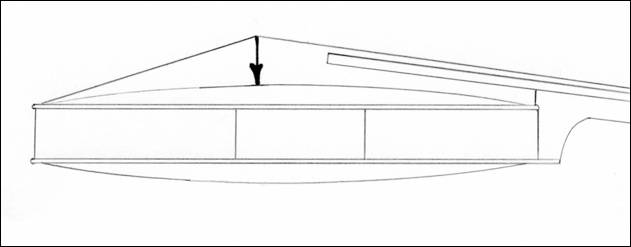
The arrow is indicating the pressure, or downforce, on the bridge.
This tension is the result of a combination of factors.
On one side, there is the tension generated by the strings. This tension is determined by :
- the string material (density and weight)
- the string vibrating lenght
- the tuning (pitch)
- the string diameter, or thickness.
Changing one of these factors, will change the string tension.
On the other side, there is the angle of the strings crossing the bridge. The angle is determined by :
- the neck-fingerboard angle
- the height of the bridge
- the height of the arch of the belly
- even the shape of the tailpiece
Changing one of these factors, will change the angle of the strings.
For the same string tension, a steeper angle will generate more down force than a flatter angle.

High pressure on the bridge
Low pressure on the bridge
This means that if one of these factors is changed, the downforce, or the tension on the instrument is changed !
Consequently, it means that, for instance, high tension strings on a flat angle can generate more downforce than lower tension strings on a steeper angle.
So how can this downforce on the bridge be measured ?
I use the following method : by using a scaled balance ( the type fishermen use, as shown on the picture ).
By pulling up the strings in exactly the opposite direction of the bridge, I can read how much Kg is needed to lift up the strings from the bridge.
The force needed to lift up the strings, is equal to the force (Kg/df), pushing downwards on the bridge.

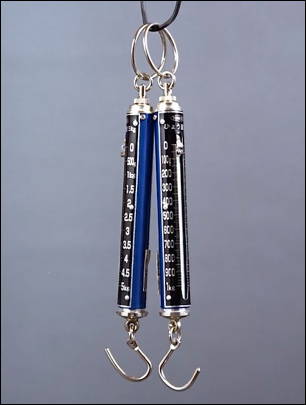
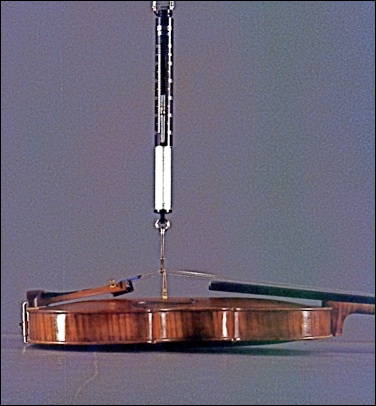
Using a balance scale to measure the Kg/df on a violin.
Before measuring the downforce, first let’s have a closer look at the string angles used on different period instruments. On the previous page, we saw the string angles were made increasingly steeper over time.
It is very easy to learn what the average standard string angle for modern violins is. There are modern violins all around us, so it is easy to measure !
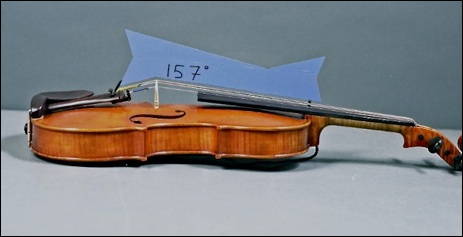
String angle of 157˚ on a modern violin
There we are : 157°
This is a very common standard, for more than 50 years now, it has been used internationally by many makers, factories and violin making schools.
It has to be mentioned that in earlier times, there was not as much a standard for everything, as we know today. For instance, today we say baroque pitch was at 415Hz, but this is only an accepted average. It is known that in the late 17th and early18th cent. the used pitch varied a lot. Sometimes, someplaces, it was much lower than 415Hz, there are, for instance, sources indicating pitches used around 390 Hz. We do know though, that on average, it was lower than today’s 440Hz.
The same is true for violin construction. During the baroque period, and later, there was much less a universal violin making method than we know today. So I should say that the string angles I use for baroque instruments, are only an average, not so much a standard. 0.5˚ more or less, is very acceptable. We do know though, that they were flatter than what is used today.
Having used the construction methods, described in the previous pagefor many years, I come to an average string angle of 159˚-159.5˚ on my baroque violins.
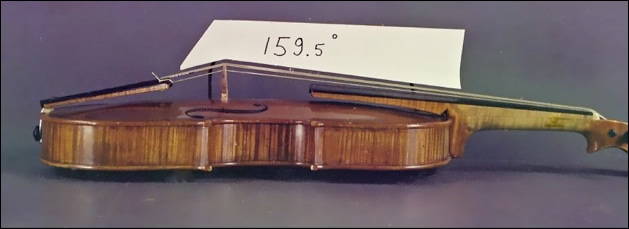
String angle of 159.5˚ on my baroque violin.
Note that the actual string angles here, are all measured on the A and D strings of the violin. If you would try to measure this yourself, you will see that, because of the shape of the bridge and tailpiece, not all strings always have exactly the same angle.
Especially the E string often has a flatter angle than the others. This can even be more so for modern violins equipped with a separate fine tuner on the tailpiece, for the first string. I just find that the angle of the A string, often represents the best average for the instrument.
What I have measured
A 1970 - 2000 VIOLIN
Let’s start with measuring the down force (Kg/df) on a standard modern violin, with a string angle of 157°, a standard string lenght of 328mm. always tuned at a pitch of 440Hz. Here are the results of a few different brands of strings :
On a set of medium tension violin strings , made by a German brand, I have measured the following Kg/df.
| 1st. e | steel string | 3.00 Kg/df |
| 2nd. a | synth.composit core/ alu wound | 2.15 Kg/df |
| 3th. d | synth.composit core/ alu. wound | 1.95 Kg/df |
| 4th. g | synth,composit core/ silver wound | 1.85 Kg/df |
Using a set of medium tension violin strings made by a French company, I measured this :
| 1st. e | steel string | 3.00 Kg/df |
| 2nd. a | alu. wound on synth, core | 2.10 Kg/df |
| 3th. d | alu. wound on synth. core | 2.10 Kg/df |
| 4th. g | silver wound on synth.core | 2.15 Kg/df |
Finally, I measured a set, that have been one of the most popular brands for violin strings of the last decades, made by an Austrian company. I did not use this makers first string, so I shall not include a result for the e string here. I used medium tension strings for the 3 strings.
| 2nd. a | alu. wound on perlon core | 2.20 Kg/df |
| 3th. d | alu. wound on perlon core | 1.75 Kg/df |
| 4th. g | silver wound on perlon | 1.80 Kg/df |
A 1950 VIOLIN
Since the purpose of this exercise is to find out what a reasonable tension on a baroque violin would be, I beleive one should not compare steel or synthetic core strings to gut strings. I know that these kind of strings exist (or are commonly used) only since the last 50 years or so. Exept for the use of steel for the 1st. e string ; these have been introduced as early as the 1920’s.
So what would a modern violin equipped with gut strings, be ?
Let’s say a 1950 violin. I know in those days, many people were still using gut strings, usually silver wound for d and g strings, sometimes wound, but often still plain gut for the 2nd. a-string. Some musicians still even disliked the use of a steel 1st string, and preferred to use a plain gut one.
One advantage here, compared to 17th and 18th cent. strings and instruments, is that we do know the string angles (in 1950, already 157˚ was common), the tuning pitch (440Hz.) and most important here, the thicknesses used for medium tension strings. There still are a few brands that still produce the same (gut) strings as during the 1950’s !
Here is what I have measured using medium tension strings made by a German company:
| 1st. e | plain gut | 2.55 Kg/df |
| 2nd. a | plain gut | 1.93 Kg/df |
| alu. wound on gut | 1.97 Kg/df | |
| 3th. d | alu. wound on gut | 1.42 Kg/df |
| 4th. g | silver wound on gut | 1.48 Kg/df |
I sometimes use an American brand of strings, that still sells the same gut strings they made in the 1950’s - 1960’s. Here is the down force their medium tension strings generate on my violin. At the time, this brand was known for producing higher tension strings. (Modern American compared to old fashioned European maybe ?)
| 1st. e | steel (no more gut available today) | 2.90 Kg/df |
| 2nd. a | alu. wound on gut | 2.10 Kg/df |
| 3th. d | silver wound on gut | 2.05 Kg/df |
| 4th. g | silver wound on gut | 1.68 Kg/df |
MY BAROQUE VIOLIN
Last, let’s see what the tension on a baroque violin, such as I make them, is.
Using the construction methods, described on the previous page, the instrument I measured, had a string angle of 159˚. I used today’s standard baroque pitch of 415 Hz, with the following gut strings :
| 1st. e | high twist gut 0.58 mm. | 1.87 Kg/df |
| 2nd. a | high twist gut 0.74 mm. | 1.58 Kg/df |
| 3th. d | "catline" roped gut 1.06 mm. | 1.48 Kg/df |
| 4th. g | silver wound on gut | 1.27 Kg/df |
Conclusion so far
The above measurements are showing the general tendency towards the use of a higher tension over time. This would be even more obvious if I would measure the latest generations of strings. Today, many people use higher tension strings than the ones I have measured. Also, a higher pitch is sometimes used, 442Hz, even some orchestras go up to 445Hz today. To measure this, I should be calling it “A Post 2000 Violin”.
The same increase in tension can be observed in the evolution of the violins bows, the violins construction, and all other instruments.
Unfortunally, this same tendency towards an ever increasing tension can also be found in the work of manufactors of baroque instruments, as well as string manufactors.
The down force I measure on my baroque violin, was still considered average, until some years ago. Today it is considered (too) low by many !
I know that during the 17th - 18th centuries, there was not as much a standard for everything, such as we know today.
I also know that in every period, in every country or culture, there have always been some people who preferred a higher tension, some who preferred a lower one.
So it is an illusion to think we will ever be able to pinpoint exactly down how much tension a baroque violin should have, but I can rule out what does not fit into the global picture.
When I speak of an evolution of ever increasing tension, it of course does not mean that this was a linear happening. Sometimes, the evolution went fast, next, things more or less stabilized or fluctuated for some years. So we cannot say that this years tension is 1% higher than last years, and next years will be 1% higher than todays. But when we look at larger intervals, such as 50 years, or 100 years, we can clearly see that the tension used, always went up.
In other words, a 1720 violin should have less downforce than a 1950 violin, less than a 1970-2000 violin.
And yet... the last years, I have seen more and more "baroque violins" with a higher downforce than what I measured on the "1950 violin", I even have measured more downforce on a-d-and g strings than on the "1970-2000 violin" ! This is not only the result of too steep neck angles used, but also because of todays fashion of using very thick strings.
Now this is a phenomenon I sometimes saw as "a repeat of history" It kept me puzzled, why is this happening? It seems to me that this is simply part of our nature (maybe not on an individual level, but certainly as a collective one) Everywhere, once there are enough people involved, averages are going up, there is growth. Bigger, faster, stronger, higher... more.
This also has economical consequences, even for me as a violin maker. When I show up with two instruments of a similar quality, but with a different downforce, (imagine a 8.6 and a 9.4 one) I always sell the higher one first ! (I do speak from experience here)
So it is a natural evolution to see things keep on growing. Orchestras keep getting bigger, piano's heavier and stronger, violin bows still being made stiffer and heavier...
It does not disturb me to see this evolution taking place in the contemporary instruments, bows, strings, music or anything else. Although I do not always see the point of it, I regard it as a natural phenomenon, a part of our human nature.
But while I am working on period instruments, this is a pitfall I do not wish to be caught in. I believe there should not be a parallel evolution, where the period instruments being made today also, are ever getting higher tensions too.
(Although I do admit, being human, I lately have been tempted by the idea of once building an electric baroque violin...)